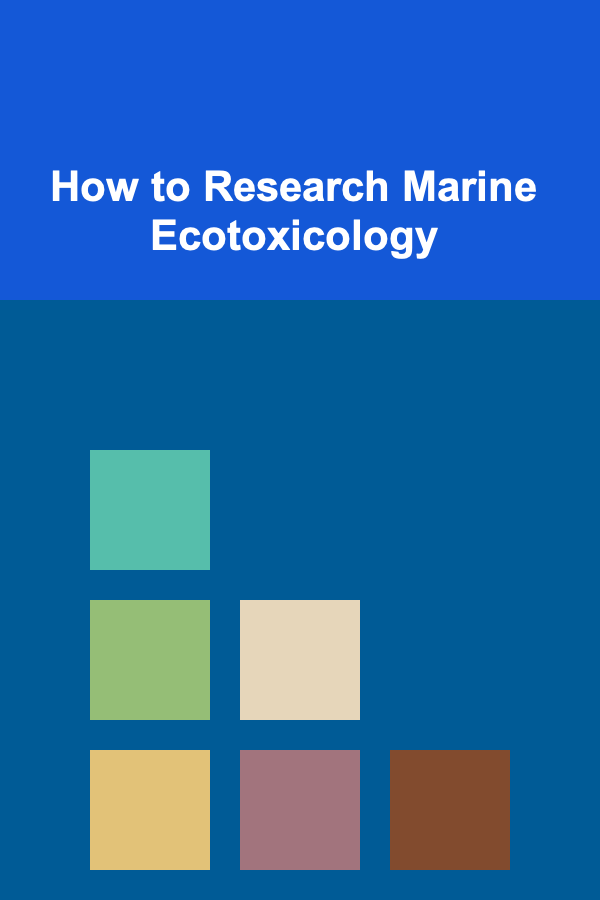
How to Research Marine Ecotoxicology
ebook include PDF & Audio bundle (Micro Guide)
$12.99$10.99
Limited Time Offer! Order within the next:

Marine ecotoxicology is a specialized field of study that focuses on the impacts of pollutants on marine ecosystems and organisms. Understanding this discipline is essential to protecting marine biodiversity, which is increasingly threatened by human activity, including pollution, climate change, and habitat destruction. Research in marine ecotoxicology integrates several scientific disciplines, including marine biology, chemistry, toxicology, environmental science, and ecology. This article provides a detailed approach to researching marine ecotoxicology, covering the methodologies, challenges, and future directions in the field.
Understanding Marine Ecotoxicology
Marine ecotoxicology is the study of the effects of toxic substances on marine organisms and ecosystems. It is concerned with both the immediate and long-term consequences of pollutants, such as heavy metals, pesticides, plastics, and pharmaceuticals, on marine life. Marine ecotoxicology is critical because the oceans are home to a vast diversity of species and provide essential services, such as oxygen production, carbon sequestration, and food resources.
1.1 Importance of Marine Ecosystems
Marine ecosystems are incredibly diverse and cover about 71% of the Earth's surface. They play a crucial role in regulating the planet's climate, supporting global biodiversity, and providing resources like food and raw materials for industries. The marine environment includes various habitats, such as coral reefs, coastal wetlands, mangroves, and deep-sea ecosystems, all of which are susceptible to the impact of pollutants.
1.2 Types of Pollutants in the Marine Environment
Pollutants in marine ecosystems can originate from both point and non-point sources. Some common types of marine pollutants include:
- Heavy Metals: These include mercury, lead, and cadmium, which can accumulate in marine organisms and enter the food chain.
- Pesticides and Herbicides: Chemicals used in agriculture can run off into oceans and affect marine life, including fish, shellfish, and coral reefs.
- Oil Spills: Petroleum-based pollutants can cause significant harm to marine organisms and ecosystems.
- Plastics: Non-biodegradable plastics are a major threat, as they can break into microplastics and be ingested by marine organisms.
- Pharmaceuticals: Drugs and personal care products that are improperly disposed of can contaminate marine environments.
- Nutrient Runoff: Excessive nutrients from fertilizers can lead to harmful algal blooms, which disrupt marine food webs.
1.3 Key Concepts in Ecotoxicology
Ecotoxicology is based on the principle that pollutants have toxic effects on organisms at various levels, ranging from individual organisms to populations and entire ecosystems. Key concepts in ecotoxicology include:
- Toxicity: The degree to which a substance can harm organisms. Toxicity can be acute (short-term) or chronic (long-term) and varies depending on the concentration and exposure time.
- Bioaccumulation: The process by which pollutants accumulate in the tissues of organisms over time.
- Biomagnification: The increase in concentration of a pollutant as it moves up the food chain, from primary producers to apex predators.
- Threshold Effects: The concentration at which a pollutant begins to cause harm to an organism or ecosystem.
Approaches to Marine Ecotoxicology Research
Research in marine ecotoxicology employs a variety of approaches to investigate the effects of pollutants on marine organisms and ecosystems. These methods range from laboratory studies to field-based research and rely on the integration of several scientific disciplines.
2.1 Laboratory Studies
Laboratory studies are crucial for understanding the specific effects of pollutants on marine organisms. Controlled experiments allow researchers to isolate the impact of a single pollutant and determine its toxicity at different concentrations.
2.1.1 Experimental Design
To conduct laboratory-based marine ecotoxicology research, scientists typically use test species, such as fish, mollusks, crustaceans, and algae. The design of the experiment involves exposing these organisms to various concentrations of pollutants under controlled conditions. Key elements of experimental design include:
- Choice of Organism: Select organisms that are representative of the ecosystem being studied. For example, bivalves (e.g., mussels) are commonly used in studies of bioaccumulation, while fish are often used to examine the effects of pollutants on growth and reproduction.
- Test Conditions: Control factors such as temperature, salinity, and light to simulate the marine environment.
- Pollutant Exposure: Expose organisms to a range of pollutant concentrations to identify threshold levels where toxic effects occur.
- Endpoints: Measure biological endpoints, such as growth rate, survival rate, behavior, reproductive success, and biochemical markers of stress.
2.1.2 Common Tests and Bioassays
Marine ecotoxicology researchers use a variety of standard tests to assess toxicity:
- Acute Toxicity Testing: Short-term exposure tests used to assess the lethal concentration of a pollutant (LC50) at which 50% of the organisms die within a specified period.
- Chronic Toxicity Testing: Long-term exposure studies that examine the effects of pollutants on growth, reproduction, and survival over extended periods.
- Bioaccumulation Studies: Measuring the concentration of pollutants in the tissues of organisms over time to understand the process of bioaccumulation.
- Behavioral Studies: Observing changes in the behavior of organisms, such as feeding, swimming, or migration, to identify sublethal effects of pollutants.
2.2 Field Studies
Field studies are essential for understanding how pollutants affect marine ecosystems in natural environments. These studies often involve the collection of samples from marine habitats, including water, sediment, and organisms, to assess pollution levels and its impact on the ecosystem.
2.2.1 Monitoring Programs
Many countries and organizations run long-term environmental monitoring programs to track pollution levels in marine environments. These programs collect data on water quality, pollutant concentrations, and the health of marine organisms. Common field monitoring approaches include:
- Sediment Sampling: Sediments often act as sinks for pollutants, where they accumulate over time. Analyzing sediment cores can provide valuable information on historical pollution levels and trends.
- Marine Species Surveys: Regular surveys of marine life, such as fish populations or benthic communities, can indicate the overall health of an ecosystem.
- Trophic Level Analysis: Studying food webs and the transfer of pollutants between different trophic levels can help identify the extent of biomagnification in an ecosystem.
2.2.2 Environmental Impact Assessments (EIA)
Environmental impact assessments (EIA) are critical tools used to evaluate the potential consequences of human activities, such as oil drilling or coastal development, on marine ecosystems. In the context of marine ecotoxicology, EIAs assess the likelihood of pollutant exposure to marine organisms and predict the potential ecological impacts.
2.3 Modeling and Computational Studies
Advancements in computational modeling are allowing scientists to predict the spread of pollutants in marine environments and assess their impact on ecosystems. Marine ecotoxicology models often use data from laboratory and field studies to simulate the behavior of pollutants over time and space.
2.3.1 Fate and Transport Models
Fate and transport models predict the movement and distribution of pollutants in marine environments. These models take into account factors such as ocean currents, temperature, and salinity to estimate how pollutants will spread through water columns, sediments, and marine food webs.
2.3.2 Ecological Risk Assessment (ERA)
Ecological risk assessment models are used to assess the likelihood of adverse ecological effects from pollutants. These models integrate exposure data (e.g., pollutant concentration) and effect data (e.g., toxicity data) to estimate the potential risk to marine species and ecosystems.
Challenges in Marine Ecotoxicology Research
While marine ecotoxicology research is crucial for understanding the impacts of pollutants, it faces several challenges.
3.1 Complexity of Marine Ecosystems
Marine ecosystems are inherently complex, with multiple interacting species and environmental factors. This complexity makes it difficult to predict the effects of pollutants on marine life and to extrapolate laboratory findings to real-world conditions. Factors such as water temperature, salinity, and biodiversity all influence how pollutants affect marine organisms, and these factors can vary significantly between different ecosystems.
3.2 Lack of Standardized Methods
Although there are standardized bioassays for testing toxicity, the field of marine ecotoxicology lacks universally accepted methods for assessing the long-term impacts of pollutants on ecosystems. Researchers often use different protocols and endpoints, which makes it difficult to compare results across studies.
3.3 Interactions Between Pollutants
Marine organisms are rarely exposed to a single pollutant in isolation. They are often exposed to complex mixtures of pollutants, including heavy metals, plastics, and chemicals. These pollutants can interact in ways that are not well understood, leading to synergistic or antagonistic effects. For example, a pollutant that is relatively harmless on its own may have toxic effects when combined with another substance.
3.4 Climate Change
Climate change is exacerbating the effects of pollution on marine ecosystems. Rising ocean temperatures, ocean acidification, and altered currents can influence the toxicity and bioaccumulation of pollutants. These factors complicate the assessment of ecological risks and the development of effective conservation strategies.
Future Directions in Marine Ecotoxicology Research
Despite the challenges, marine ecotoxicology research is advancing rapidly. Several emerging trends and technologies are shaping the future of the field.
4.1 Advances in Analytical Techniques
The development of more sensitive analytical techniques, such as mass spectrometry and high-resolution chromatography, is allowing researchers to detect pollutants at trace levels. These advancements will improve our ability to monitor pollutants in marine environments and understand their distribution and impact.
4.2 Microplastic Research
Microplastics are a growing concern in marine ecotoxicology, and research into their effects is expanding. These tiny particles, which result from the breakdown of larger plastic items, can be ingested by a wide range of marine organisms. Research is focused on understanding the sources, pathways, and ecological effects of microplastics, as well as developing methods to mitigate their impact.
4.3 Ecosystem-Based Approaches
Ecosystem-based management approaches are gaining traction in marine conservation. These approaches recognize the interconnectedness of marine species and their habitats and aim to protect entire ecosystems rather than focusing on individual species. This holistic approach is essential for addressing the cumulative impacts of pollution on marine environments.
4.4 Global Collaboration
Marine pollution is a global issue, and effective solutions require international collaboration. Scientists, policymakers, and environmental organizations are increasingly working together to address marine pollution through initiatives such as the United Nations Clean Seas Campaign and the Global Partnership on Marine Litter.
Conclusion
Research in marine ecotoxicology plays a critical role in understanding the impacts of pollutants on marine ecosystems and guiding conservation efforts. By employing a range of laboratory, field, and computational approaches, scientists are gaining valuable insights into the toxicity, bioaccumulation, and ecological risks posed by pollutants in the ocean. Despite the challenges, advances in research techniques and international cooperation are helping to pave the way for more effective solutions to protect marine life and ensure the sustainability of ocean ecosystems. As the field of marine ecotoxicology continues to evolve, it holds the promise of better safeguarding our oceans for future generations.
Reading More From Our Other Websites
- [Screen Printing Tip 101] Common Mistakes New Screen Printers Make---And How to Avoid Them
- [Home Space Saving 101] How to Design a Small Dining Space That Works
- [Personal Financial Planning 101] How to Create a Personal Financial Plan Specifically for Freelancers and Gig Workers
- [Personal Care Tips 101] How to Make Your Own Natural Exfoliating Body Scrub at Home
- [Home Staging 101] How to Stage Your Home's Garden for Outdoor Entertaining
- [Home Lighting 101] How to Layer Lighting in Your Bedroom for Maximum Comfort
- [Home Renovating 101] How to Design a Spa-Like Bathroom Retreat
- [Home Party Planning 101] How to Plan a Stylish Home Party with Limited Space
- [Home Security 101] How to Create a Home Inventory for Security and Insurance
- [Home Holiday Decoration 101] How to Create a Stunning Holiday Table Centerpiece on a Budget

How to Make Money Online as an Occupational Health Nurse: 10 Actionable Ideas
Read More
How to Maximize Closet Space Without Renovating
Read More
How to Set Up a DIY Dessert Table for Your Home Party
Read More
How to Use Technology to Manage Your Home Budget Effectively
Read More
How to Make Homemade Gnocchi
Read More
10 Tips for Building a Sustainable To-Do List System That Saves Time and Money
Read MoreOther Products

How to Make Money Online as an Occupational Health Nurse: 10 Actionable Ideas
Read More
How to Maximize Closet Space Without Renovating
Read More
How to Set Up a DIY Dessert Table for Your Home Party
Read More
How to Use Technology to Manage Your Home Budget Effectively
Read More
How to Make Homemade Gnocchi
Read More